|
If there is one panorama that is a signature depiction of the Arts in 2008 and the future, it is the accelerating montage of merged media that is China, aggressively flaunted in its new architecture. Why? As the husband of the next President of the United States once said: "It's the economy, stupid!" The explosion of profits in China, money, has set off a parallel explosion in art. The loudest echo comes from the premier event this year in Asia, an event that will expose the potential of media art groups from 30 countries: The Olympics. They are using their knowledge and abilities to develop and create new inventions and to follow new technologies. After four years of preparation, the song "We are ready" is already playing in Beijing.
Here is just a sampling of some of the new forms and new media that is emerging.
Olympic Stadium in Beijing
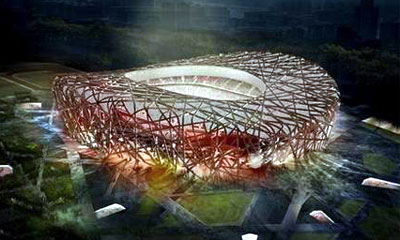
Many stadiums in the world are designed on the concept of the world famous coliseum in Rome. Architect Herzog & de Meuron, tried to create a new more nature-friendly concept. that more nature friendly than before. The Swiss architect created natural air vents in the 91,000 seat stadium. The exterior is resembles to bird's nest which derives from the metal net structure in the shape of branches, It is covered with a transparent roof and walls. The stand is in a red bowl shape and it looks like the famous forbidden palace in green and gray walls.The ladders were made to match the metal net and reflects the unity of design.
Beijing International Airport
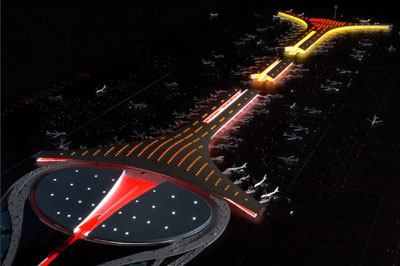
More than 1,000,000 sq meters in area, larger than the pentagon in the U.S, it was designed by the creator of Hong Kong's airport Chek Lap Kok.It is the world's largest and most advanced airport building, not only technologically, but also in terms of passenger experience, operational efficiency and sustainability. Beijing International Airport is designed to be welcoming and uplifting. A symbol of place, its soaring aerodynamic roof and dragon-like form celebrates the thrill of flight and evokes traditional Chinese colors and symbols.
Monetary Center of the World in Shanghai
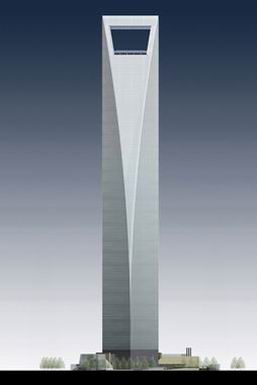
The new monetary center of the world will be revealed at Shanghai in the form of 101 stories skyscraper. Kohn Pedersen Fox, architect said that the construction of the wind resistant building is the challenge. The top of the building is in rectangular shape. And the 100th story is the highest resting point and is designed to reduce wind and the shake of the building.
The National Swimming Pool in Beijing
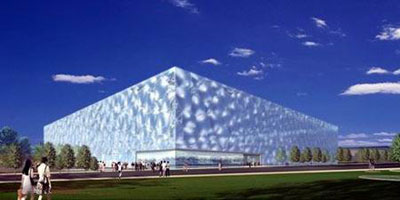
Built specifically for the Olympics 2008, it looks like a "big water cube". PTW and Ove Arup used Teflon as a base and concentrated on solar energy to generate electricity for the building and the waste water treatment system.The water is kept in an underground big reservoir. Moreover, to make sponge walls, the architects used technology provided by physicists from Dublin's Trinity College. Apart from the realistic sponge wall, this swimming pool is quite unique and can endure the shake of a strong earthquake.
Central Television (CCTV) in Beijing
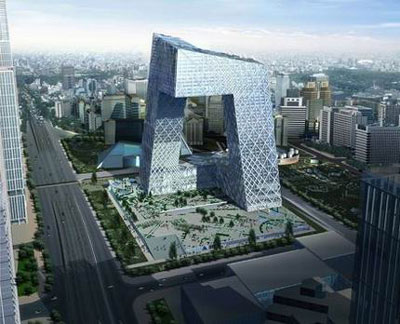
This is the new building of the television station (CCTV). The appearance is quite different from normal skyscrapers. Two buildings merged together that look like a big tunnel, designed to minimize the effects of wind storms.
Linked Hybrid in Beijing
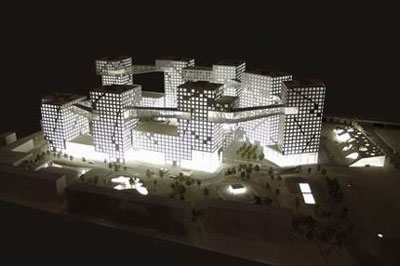
These buildings are the location of 2,500 houses and 700 apartments on 1.6 Million sq feet. This is the largest building that utilizes a bio system to give appropriate cold and heat for 8 buildings. Its 20th stage is built in a ring shape and connected to all buildings with many services.
National Theatre in Beijing
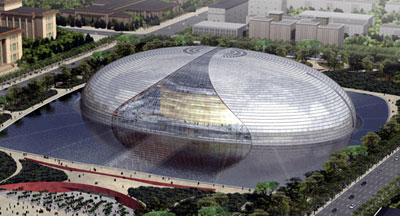
Architecture in the middle of Beijing City and near Tian An Men square and the official opening is in 2008. Exterior was made from glass and titanium. The designer is Paul Andro, a French architect. His famous work is "Building 1" of Charles de Gaul airport. In this theatre, there are 2,416 seats in the Opera Theatre, and 2,017 seats in the concert hall. The Cinema has 1,040 seats. The walls are semi-transparent and people from outside can see the show a little bit. This is one of its outstanding characteristics.
What is New Media Art?
It is a genre that encompasses artworks created with new media technologies, including computer graphics, computer animation, the Internet, interactive technologies, robotics, and biotechnologies. The term differentiates itself by its resulting cultural objects, which can be seen in opposition to those deriving from old media arts (i.e., traditional painting, sculpture, etc.) This concern with medium is a key feature of much contemporary art and indeed many art schools now offer a major in "New Genres" or "New Media." New Media concerns are often derived from the telecommunications, mass media and digital modes of delivery the artworks involve, with practices ranging from conceptual to virtual art, performance to installation.
More recently, the term "new media" has become closely associated with the term Digital Art, and has converged with the history and theory of computer-based practices. Ever since the early days of computing there have been a dedicated few who toiled to create pieces of art in the digital medium. It wasn't until the advent of the commercial internet in the late 80's and early 90's that digital art attracted a broader range of artists.
During the 2008 Beijing Olympic Games, the National Art Museum of China will present "SYNTHETIC TIMES: Media Art China 2008" in its current location at the center of Beijing. NAMOC is the national art museum in China that is dedicated to research, presentation and promotion of modern and contemporary arts. "China International New Media Arts Exhibition 2008", scheduled from June 30th to July 30th, will be one of the most important cultural events leading up to the Olympic Games in Beijing.
The exhibition will occupy approximately 4500 square meters (48000 square feet) of the museum gallery space and an additional outdoor area of ca. 3000 square meters (32000 square feet). The internationally recognized Dutch architecture firm NOX/Lars Spuybroek will architecturally transform the galleries in response to the nature of the works on display. A full-color catalogue will be co-published by NAMOC and the MIT Press to accompany the opening (with international distribution). An online forum dedicated to the discourse of the respective exhibition themes and beyond will be created prior to the opening of the event. A pre-Exhibition symposium will be held in New York City in collaboration with MoMA (Museum of Modern Art) and other major cultural and educational institutions. The forum and the subsequent symposia will be moderated by a group of distinguished scholars and media arts professionals. Selected discussion essays will be included in the catalogue. Meanwhile, a number of satellite exhibition venues have been planed within the greater Beijing art community (such as Factory 798 and Jiou Chang), engaging prominent galleries of the booming Beijing art scene. In addition, a number of special evening events during the opening days of the Exhibition are conceived to celebrate countries with significant contribution to the development of media art and culture.
SYNTHETIC TIMES: Media Art China 2008 will showcase both established and emerging artists from approximately thirty countries, and over fifty media art works will be on view along with performances, workshops and symposia. The Museum of Modern Art (MoMA) will contribute a special screening program consisting of seminal video art works. The Exhibition is envisaged as a landmark event in the history of contemporary Chinese art dedicated to embracing the most innovative artistic production and theorization to date, and aspiring to foster and advance new modes of thinking and novel ways of artistic engagement in an increasingly technologically immersed society and global cultural landscape, resonating with the leitmotifs of "Cultural Olympics" and "Hi-Tech Olympics" put forward by the 2008 Beijing Olympic Games.
Organization
Presented by:
National Art Museum of China
Collaborating Institutions
V2_Institute for the Unstable Media, Rotterdam
ZKM Center for Art and Technology, Karlsruhe
Ars Electronica Center, Linz
Le Groupe Molior, Montreal
Plug-in, Basel
FACT, Liverpool
Tate, London
European Media Art Festival, Osnebrueck
MoMA (Museum of Modern Art), New York
Multimedia Art Asia Pacific, Brisbane
The MIT Press, Cambridge
Eyebeam, New York
Parsons School of Design, New York
and others
About the NAMOC
The National Art Museum of China, established in 1963, is China's only national art museum, belonging to the Ministry of Culture of the People's Republic of China. The main collection at the NAMOC comprises both 20th century and contemporary Chinese artwork, currently amounting to about 70,000 works. Besides displaying selections from the main collection, the NAMOC not only plays host to various contemporary art exhibitions, but also publishes monthly, academic magazines, holds educational events for the public, and welcomes millions of visitors annually.
The Museum has established professional relationships with many of the worlds' most prestigious art museums. Prominent large-scale exhibitions that were recently displayed at the NAMOC include "French Impressionism," "300 Years of Russian Art," "20th Century Mexican Art," and "Modern Italian Painting." Collaboration with the Guggenheim Museum will culminate in 2007 in the presentation of "300 Years of American Art." Among other events, 2007 also brings "An Exhibition of the Works of Spanish Master Painters," sponsored by Spain's Prado Museum.
At the time of the 2008 Beijing Olympics, the NAMOC's galleries will be opening with a series of notable exhibits including "Beijing Biannual of International Art." The "SYNTHETIC TIMES: Media Art China 2008", will be one of Beijing's most important cultural events of the year.
And they are ready!
|
